ISSN ONLINE(2319-8753)PRINT(2347-6710)
ISSN ONLINE(2319-8753)PRINT(2347-6710)
A.Raveendra1, Dr.B.V.R.Ravi Kumar2
|
| Related article at Pubmed, Scholar Google |
Visit for more related articles at International Journal of Innovative Research in Science, Engineering and Technology
In this experimental work tests were conducted on the weldments of SS304using GTAW with pulsed current and non-pulsed current at different frequencies of 5Hz,&10Hz on 3mm thick sheets. Hardness test, tensile test and microstructure results of weldments were studied . The aim of this experimental work is to see the effect of pulsed current on the characteristics of weldments. The experimental results pertaining to different welding parameters for the above material using pulsed and non-pulsed current GTAW are discussed and compared.
Keywords |
| SS304, Gas Tungsten Arc Welding, Constant Current Welding, Pulsed current welding and Heat Affected Zone. |
INTRODUCTION |
| The demand is increasing for aluminium alloy and stainless steel weld structures and products where high quality is required such as aerospace applications. Aluminium alloy and stainless steel can be welded easily by conventional arc welding methods like metal inert gas (MIG) and Tungsten Inert Gas(TIG).Among the two methods the gas tungsten arc welding(GTAW)process has proved for many years to be suitable for welding aluminium alloy and alloy steels and stainless steels, since it gives best quality welds. The DCSP GTAW process was used in this study for welding SS304 steel. Further development has been pulsed current TIG welding. Pulsed current welding (pcw) was introduced in the late 1960’s as a variant of constant current welding(ccw). pcw process has many advantages over ccw, including enhanced arc stability, increased weld depth/width ratio, narrower HAZ range, reduced hot cracking sensitivity, refined grain size, reduced porosity, low heat input, lower distortion of gas by weld pool and better control of the fusion zone [1-8]. Pulsed current welding technology has been widely used in fabrication of high pressure air bottles, high pressure gas storage tanks, rocket motors, structures in aerospace applications such as aircrafts, rockets and missiles. Switching between predetermined high and low level of welding current can be used to produce pulsed current gas tungsten arc welds[9]. |
| Current pulsing has been used by a few investigators[2,3]to obtain grain refinement in weld fusion zones and improvement in weld mechanical properties. So far the pulsed current welding is used to study the effect of pulse current, shielding gas composition, weld speed, bead shape , the incidence of welding defects, joint strength , using alloy sheets of 5083 type [8] angular distortion in SS310 type [9] , to study the microstructure [10] and weld bead geometry [11]. Usually the pulsed waves are in rectangular shape and the parameters used for pulsed GTA welding are in shown in figure 1. The main characteristics of PCW are determined by peak current Ip base current Ib , peak time tp and base time tb. |
EXPERIMENTAL PROCEDURE |
| The work pieces were made of SS304 of thickness i.e. 3mm . The test specimens were machined in the size of 150 mm X 300 mm welded with pulsed and non-pulsed current GTAW process. |
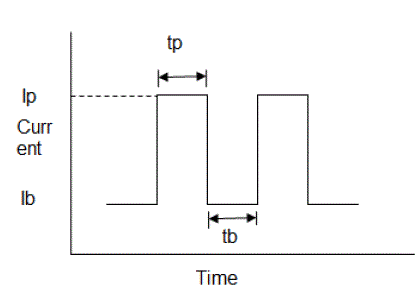 |
| Fig.1 Parameters used for pulsed GTAW: peak current Ip, base current Ib , peak time tp and base time tb. |
| SS304 filler wire was used during the welding , which reduced the weld cracks and produced the good strength and ductility than other filler metals [12]. These filler metals melt at a temperature lower than that of the base metal. For this reason , it yields during cooling , since it remains more plastic than the base metal and relieves the contraction stresses that might cause cracking. The chemical composition and mechanical properties of work material were shown in Tables 1&2. The steel work pieces were roughly polished with 400 grit abrasive paper and pneumatic rotary brush to remove surface impurities and then clean with Acetone. A Mastertig AC/DC 3500W GTAW machine (fig 3&4) with DC was used for welding of SS 304 test specimens .The choice of tungsten electrode depends upon the type of welding current selected for the application. Zirconated tungsten (EWZr) electrodes are best suited for AC wherein they keep hemispherical shape and thoriated tungsten electrodes (EWTh-2) should be ground to taper are suitable for DCSP welding are used for this purpose [13]. This welding process was conducted with 2.5 mm diameter 2% Thoriated tungsten electrode. The welding parameters used for this welding process both in pulsed current and non-pulsed current for two different thicknesses of the above material is given in Tables 3&4. The edge preparation of SS304 specimens are shown in figure 2. After welding process is over, Hardness test, Tensile strength test and microstructure tests were carried out on the weldments. |
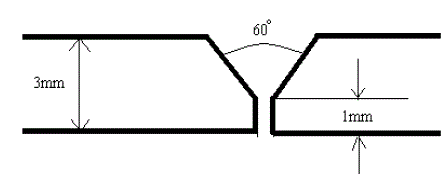 |
| Fig.2 Edge preparation of weld specimens |
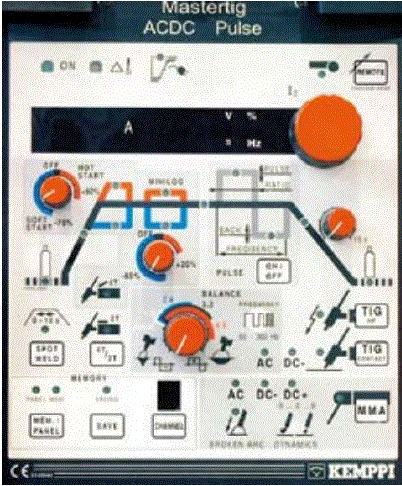 |
| Fig.3 AC/DC Pulse Panel |
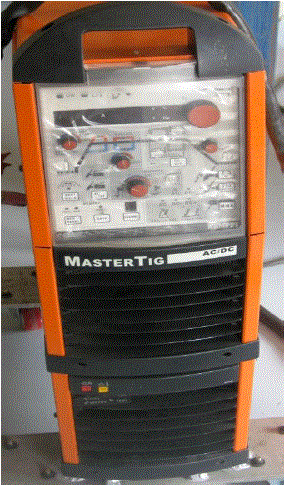 |
| Fig.4 Mastertig AC/DC 3500w |
| Table 1. Chemical Compositions of work material SS304 |
 |
| Table 2. Mechanical properties of SS304 at heat treated condition |
 |
| Table 3. Welding parameters for non-pulsed current welding of SS304 |
 |
| Table 4. Welding parameters for pulsed current welding of SS304 |
 |
| Table 5. Hardness values at different locations across weld bead |
|
|
| Table 6. Tensile strength values of weldments |
 |
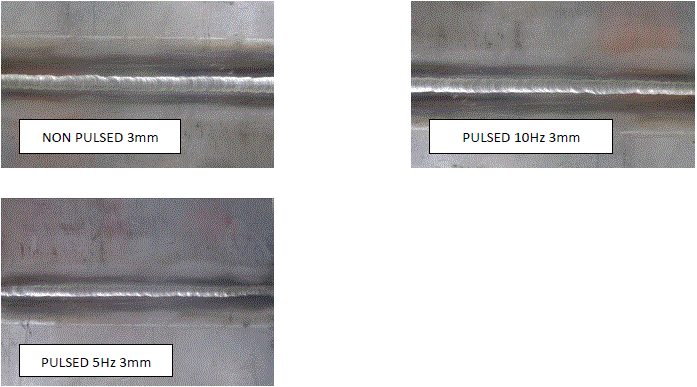 |
| Fig.5. Welded Plates of Stainless Steel 304 |
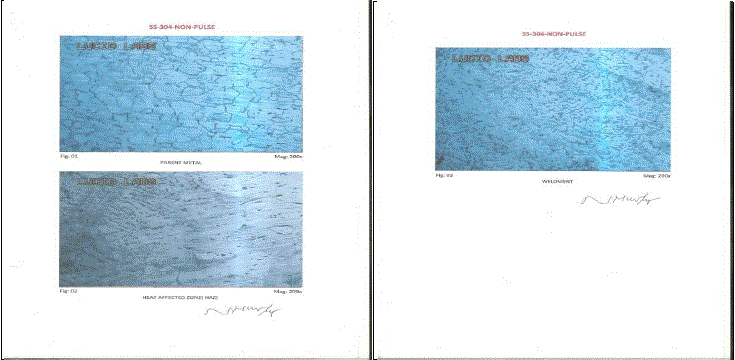 |
| Fig.6. Microstructure of Non-Pulsed Current TIG Weldments |
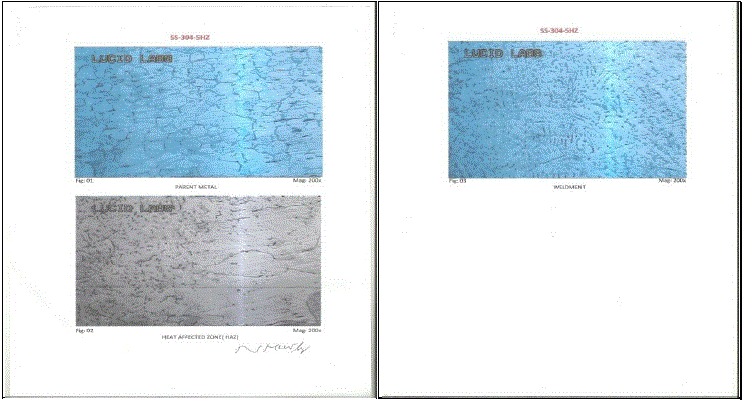 |
| Fig.7. Microstructure of 5 Hz Current TIG Weldments |
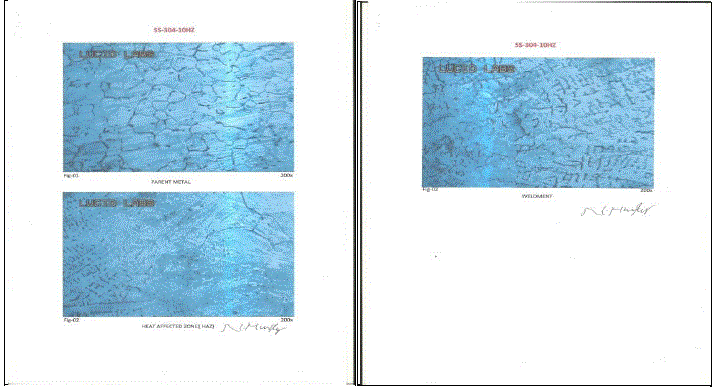 |
| Fig.8. Microstructure of 10 Hz Current TIG Weldments |
RESULTS AND DISCUSSION |
A. EFFECT OF FREQUENCY ON THE HARDNESS |
| The effect of frequency on the hardness at two frequencies (5Hz,10Hz&NP) was shown in table 5. Hardness was checked at different locations and observed that hardness increased in the Weld Metal Zone and HAZ zone in the weldments welded at 5HZ than the weldments done at 10HZ and Non-pulsed current. This may be due to more grain refinement due to controlled heat input at 5HZ pulsed current welding than 10HZ and non-pulsed welding. |
B. EFFECT OF FREQUENCY ON THE TENSILE STRENGTH |
| The effect of frequency on the tensile strength at two frequencies (5Hz,10Hz&NP) was shown in table 6. The finished test specimens were tested using the universal testing machine of 10ton capacity. The weldment specimens failed through the parent metal in all the cases. It was observed that UTS and 0.2%yield strength value of non-pulsed current were more than the base metal and pulsed current weldments. The experimental results shows that theweldments produced more strength in non-pulsed current welding than the pulsed current welding, ie.645.05Mpa, 643.3Mpa, 644.73Mpa respectively. |
C. EFFECT OF FREQUENCY ON MICROSTRUCTURE |
| Weldments were tested as per ASTM E3-01,ASTM E407-1999. Microscopic examination results were as follows. 1) SS304-Non pulse : Parent metal: Micrograph showing the presence of uniform annealed grains of austenite matrix. HAZ: Micrograph showing the presence of boundry of dendritic pattern (left) and annealed parent metal (right side) Weld metal: Micrograph showing the presence of uniform distribution of fine dendritic pattern. 2) SS304- 5HZ : Parent metal: Micrograph showing the presence of uniform annealed grains of austenite matrix. HAZ: Micrograph showing the presence of boundary separating welds and parent metal structure, The grains of parent metal enlarged/grown due to heat generated during welding. Weld metal: Micrograph showing the presence of fine dendritic pattern of the weld puddle. 3) SS304- 10HZ : Parent metal: Micrograph showing the presence of uniform annealed grains of austenite matrix. HAZ: Micrograph showing the presence of boundry of weldpuddle and parent metal.The grins size enlarged due to heat transmitted during welding. Weld metal: Micrograph showing the presence of uniform but enlarged dendritic pattern. |
CONCLUSIONS |
| In this experimental work selection of process parameters for pulsed and non-pulsed current GTAW of SS304 metal were presented. Weldments were tested for their characteristics, more hardness found in the HAZ zone of the all weldments. Higher tensile strength values found in the non-pulsed current weldments. The higher hardness values may be due to grain refinement in the zone of weld metal and Heat Affected Zones. Further, experiments can be conducted using pulsed current, non-pulsed current TIG welding up on the different thick plates and welding characteristics can be studied. |
References |
|